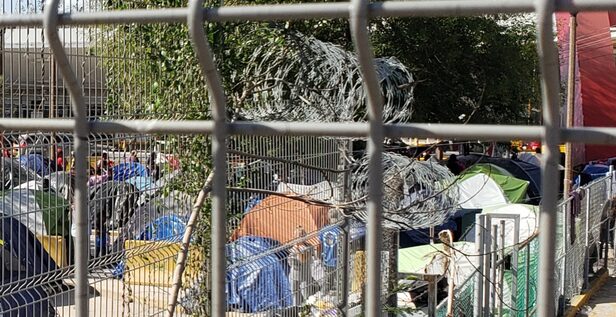I climbed the levee, walked through a gate flanked by razor wire, and looked around. A few yards higher, a woman sat alone on a castoff lawn chair, her expression empty as she watched me approach. I climbed toward her and glanced briefly at the chair beside her. It had no seat, so she stood and grabbed another from nearby. They were the only three chairs I had seen in the camp, and her act felt precious. “Me llamo Jeni,” I told her.
“Soy Violeta,” she responded.
Below us, the bright orange arches of the International Bridge pierced the morning sky, palpable through coils of military wire. Small camping tents, including Violeta’s, covered the levee, while more lined the streets below. We could just see the tops of the portable toilets, ten of them for this community of about 2,000. The smoke from Violeta’s campfire blew across our faces, but she didn’t flinch, so neither did I. It wasn’t long before she said, too matter-of-factly, “I sent my daughter across yesterday.”
Her daughter is nine years old. Violeta had stood near the bridge and watched her child leave. She waited until an officer took custody, and then Violeta walked back to her tent. Alone.
“I couldn’t let her suffer anymore,” Violeta explained. “She was raped here. We were both raped.”
“Here in the camps?” I asked, and Violeta nodded.
“Sometimes people disappear from here too. Adults and children. I couldn’t let her stay any longer.” Violeta looked away and tightened her arms across her chest. “I’m going back to Honduras now,” she added. “The gangs murdered my parents when I was three, and my grandparents raised me. Now the same gangs are targeting me. But I’m going back. There is nothing else for me to do.”
This makeshift “camp” did not exist when I last entered Matamoros this past spring. It formed by default when the U.S. government implemented the Migrant “Protection” Protocol, better known as “Remain in Mexico.” Under this policy, even migrants who demonstrate credible fear of death in their home countries are forced to wait months outside our borders to complete our now-impossible asylum process. They have no access to U.S. attorneys, clean water, adequate food, health care, or toilets.
And, like all asylum seekers, they will never be heard by a member of the U.S. judiciary branch. U.S. immigration “courts” do not operate within the judicial system, but are governed directly by the U.S. president and his attorney general. The administration’s Zero Tolerance policies mean zero chance for life.
Tragically, Violeta is one of countless mothers who make impossible choices between death and death. Some have sent children as young as three across that bridge, knowing the separation may very well be permanent.
Early this fall, I visited a different border city with a group of volunteer attorneys. Two mothers approached our team requesting birth control for their daughters, ages eleven and twelve. Rape was inevitable, they said, and they wanted to protect their girls as best they could. The cartels know easy targets when they see them. And like Violeta, these mothers acknowledged disappearances in the border camps but still found them preferable to the killings back home.
Volunteers can only bring band-aids. I managed to get a few personal water filters through customs and encourage two young families to accept flu vaccines from an extremely limited supply (twenty vaccines for 2,000 people). Because I'm a mental health professional, I distributed fliers on stress reduction, read to children, and sat to talk with hurting people. Local volunteers do a thousand times more, working every day to provide hot meals, more tents, legal information, fresh survival ideas. But the only real solution for the camps is to end the Migrant “Protection” Protocol (MPP) that brought them into existence.
Those of us who vote need to understand that MPP is genocide. The U.N. Convention on the Prevention and Punishment of the Crime of Genocide lists five deadly acts, any one of which can earn the title "genocide." They are:
- Killing members of the group;
- Causing serious bodily or mental harm to members of the group;
- Deliberately inflicting on the group conditions of life calculated to bring about its physical destruction in whole or in part;
- Imposing measures intended to prevent births within the group;
- Forcibly transferring children of the group to another group.
The Migrant “Protection” Protocol carries out genocide in at least three of these forms, and Violeta and her daughter suffered all three. MPP is a form of genocide, and we as U.S. citizens are the only ones who can stop it.
